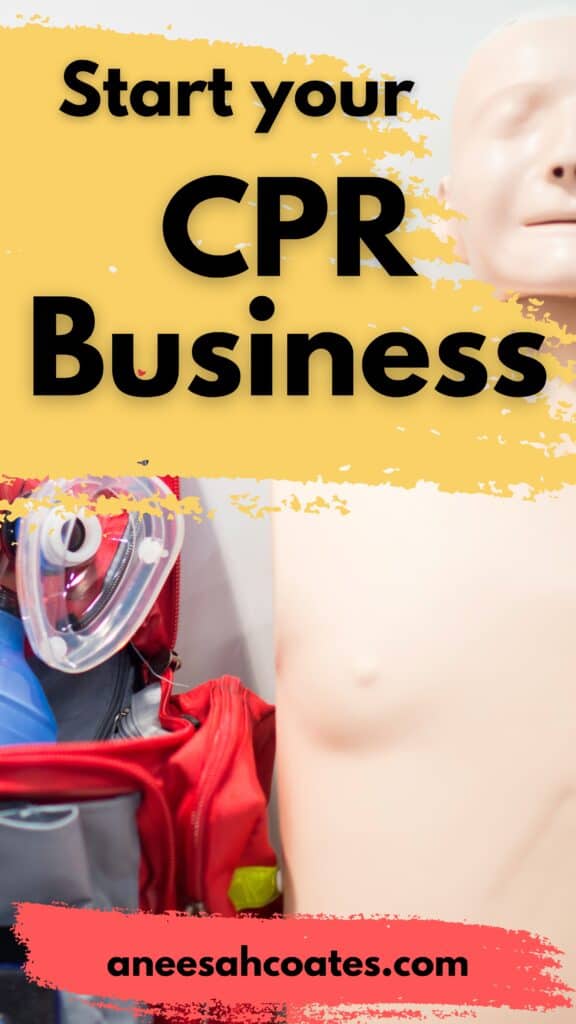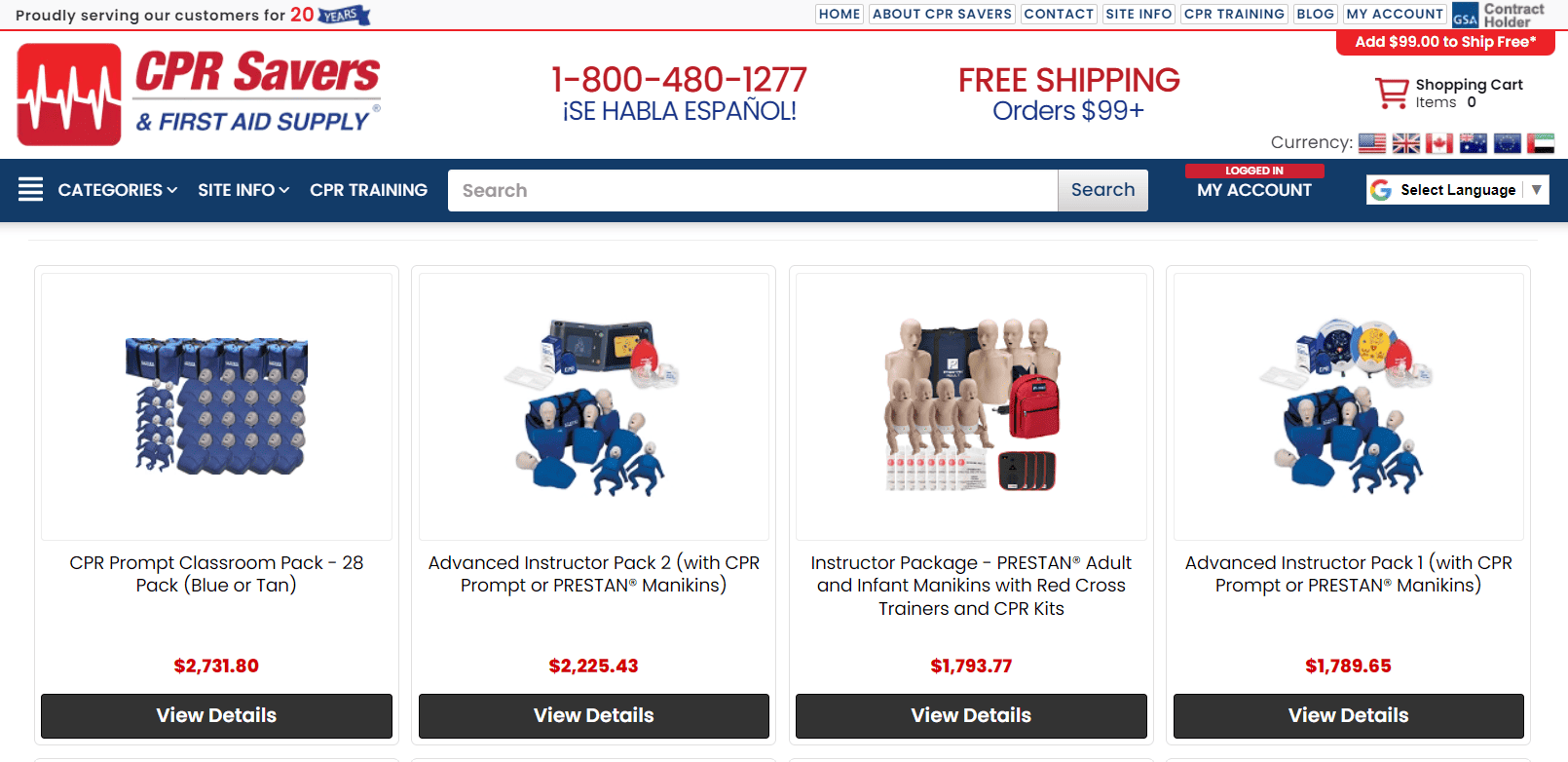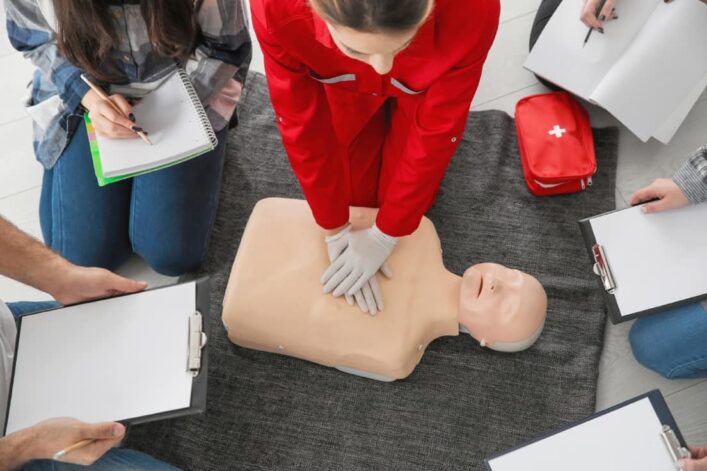

Would you like to know how to start a CPR business? If so, you’ve come to the right place!
In this blog post, we’ll provide you with tips and advice that will help you get your CPR company off the ground and running. We’ll discuss topics such as choosing a successful business model, marketing your services, and growing your client base.

So, what are you waiting for? Read on to learn everything you need to know about starting a successful CPR instructor business!
This post is for general informational and educational purposes only. You can read the full disclaimer for more information.
CPR is an acronym for cardiopulmonary resuscitation. It’s a life-saving technique that is used to revive someone who has suffered a cardiac arrest.
When someone goes into cardiac arrest, their heart stops beating and they stop breathing. CPR can help restart the person’s heart and breathing and improve their chances of survival.

There are many reasons why you might want to start your own CPR training business. Perhaps you are a trained medical professional who wants to use your skills to help others.
Or maybe you’ve witnessed a cardiac emergency firsthand and you want to be able to help others in that situation. Whatever your reasons, starting a CPR instruction business can be a very rewarding experience.
You’ll also be able to set your own hours, you can work full time or part time for some extra money.
In order to start a CPR business, the first thing you’ll need to do is become a certified CPR/ First Aid instructor. You can do this by taking a CPR instructor certification course from a reputable organization such as the American Red Cross or the American Heart Association (AHA).
Once you’ve completed a CPR instructor course, you’ll be able to teach others to perform CPR, a life-saving technique.
Offers instructor training programs to both Authorized Providers (AP) who teach Red Cross courses to individuals within the APs company or organization only.
And Licensed Training Providers (LTPs) who’s an independent CPR instructor offering Red Cross training to workplaces, individuals, or recreational and pool facilities.
| American Red Cross Licensed Training Providers can offer CPR, AED, and First Aid training.

They require that you fill out the form here. And for questions you can call this number 1-855-560-0067, Mon – Fri 9am to 6pm ET.
Offers training to new cpr instructors only after consulting with an AHA Training Center to find out whether a Training Center (TC) is accepting new instructors.
| AHA Basic Life Support Instructors can offer CPR, AED, and First Aid training.

If you plan to offer CPR certification training to a workplace be sure the certification includes OSHA requirements for workplace certification. You can check with whomever certified you as an instructor.
The steps to starting your emergency medical services, CPR, or first aid business include: come up with a great business idea, do your research, develop a business plan, get financing, and launch your business.
First, you’ll need to become certified in CPR and first aid. This is the most important step, as you’ll be teaching this vital service to your clients.
Once you’ve become a certified CPR instructor, you’ll need to develop an aim for your business.
The next step, is to come up with a good idea for your CPR business. What will you offer? Could you be the first company in your area to offer a mobile CPR training program?
How will you stand out from the competition? What about online CPR certification vs in-person classes? There are many possibilities, so it’s important to choose an idea that you’re passionate about.
After you have an idea, it’s time to do your research. This includes everything from learning about the CPR industry to figuring out who your target market is.

What’s the latest CPR research? What do other businesses in the industry offer? How can you make your own business unique?
It’s important to make sure there is a demand for your services before you launch your business. You can do this by conducting market research and talking to potential customers.
Your local community is a great place to start. Are there businesses or organizations that would benefit from having CPR-certified employees?
You can also reach out to local hospitals, schools, and daycares. Many of these organizations are required to have CPR-certified employees, so they may be interested in your services.
After you have done your research, it’s time to develop a business plan. This document will outline your business goals, strategies, and financial projections.
A business plan is essential for any new business, especially if you’re looking for financing.
Your business plan will include an executive summary, company overview, market analysis, management and marketing plans, and financial projections.

This is a brief overview of your business, including your CPR services and target market.
This section will provide the details of your company, including your business structure and location.
This section will outline the CPR industry and your target market. It will include information on your competitors and how you plan to stand out in the market.
This section will outline your business model and include your management team and marketing strategies. It should include a sales and marketing plan, as well as a social media strategy.
This section will include your financial projections for the first three years of business. It should include your start-up costs, operating expenses, and revenue projections.
If you’re not sure where to start, there are many business plan templates and resources available online.
After you have developed your business plan, it’s time to get financing. This can be self funded or can come from a variety of sources, including loans, investors, and grants.
There are many small business loans available, so it’s important to compare interest rates and terms before you choose one.
If you’re looking for investors, you’ll need to present your business plan and convince them to invest in your company. You can also look for grants that can help you finance your business.
Check out The United States Small Business Administration (SBA) for funding options as well.

It’s time to register as a legal business entity. Come up with some cpr business name ideas and choose one that conveys the values and goals of your business. Then decide on your business structure and obtain a business license.
Your business structure will determine how you file your taxes and how much liability you have. The most common business structures are sole proprietorships, partnerships, limited liability companies (LLCs), and corporations.
A tax identification number (EIN) is also required to register your business. This can be done online through the IRS website.
In most cases you’ll also need to get a business license, which you can do through your local city or county clerk or Department of State.
Depending on your business, you may need to get other licenses and permits. Such as a certificate of occupancy, liability waiver, or services agreement.
Open a business bank account. This will help you keep your personal assets and business finances separate.
Business insurance is another important step in setting up your CPR and first aid training business. This will protect you and your aid business from liability in the event that someone is injured while using your services.
Now that you have your business set up, it’s time to get the equipment you need to be a CPR instructor. This includes things like your own training materials, manikins, CPR masks, and certification cards.
How much does it cost to start a cpr business?
You can find CPR manikins at CPR Savers & First Aid Supply or on Amazon. We looked at kits from The Red Cross and American Heart Association. Kits generally range in price from $200 for single manikin kits to $2,800 for instructors that want to teach groups or offer workshops.

If you plan to offer mobile services, a nice wheeled carry bag is essential.

After you have all of your ducks in a row, the last thing is to launch your business! Start by reaching out to your network of family and friends to let them know you’re open for business.
You can also create a professional website and social media accounts to help promote your CPR services. Be sure to include your contact information, rates, and service areas on your website.
Creating marketing materials is a great way to promote your business. You can have flyers or brochures printed up with your contact information, rates, and what makes your services unique.
Put up your material in visible locations around town and distribute business cards to small businesses. Advertise any mobile or online courses you offer, as well as any discounts or promotions you may be running.
The best way to find clients for your CPR business is to get involved in your community. Build relationships with local hospitals, clinics, and doctor’s offices.
Join local chamber of commerce or business networking groups. This will help you meet other business owners and get your name out there.
To start, you can also offer specialized first aid techniques, free CPR demonstrations, or volunteer to teach CPR classes at neighborhood schools, local community centers, or senior citizen homes.

This is a great way to get people interested in your services and generate some word-of-mouth marketing.
Word-of-mouth is always a powerful marketing tool, so be sure to tell everyone you know about your new CPR business!
Another great way to find clients is to offer your services at a discount to local organizations, like the Girl Scouts or Boy Scouts.

CPR is a vital skill that everyone should know, so you’ll be doing a great service by teaching people how to perform it.
Just remember to get your business set up correctly, get the right equipment, and market your services to the right people.
With a little hard work and dedication, you’ll be well on your way to starting a successful CPR business.
Now that you know how to start your own CPR business, it’s time to get out there and put your life saving skills to work!